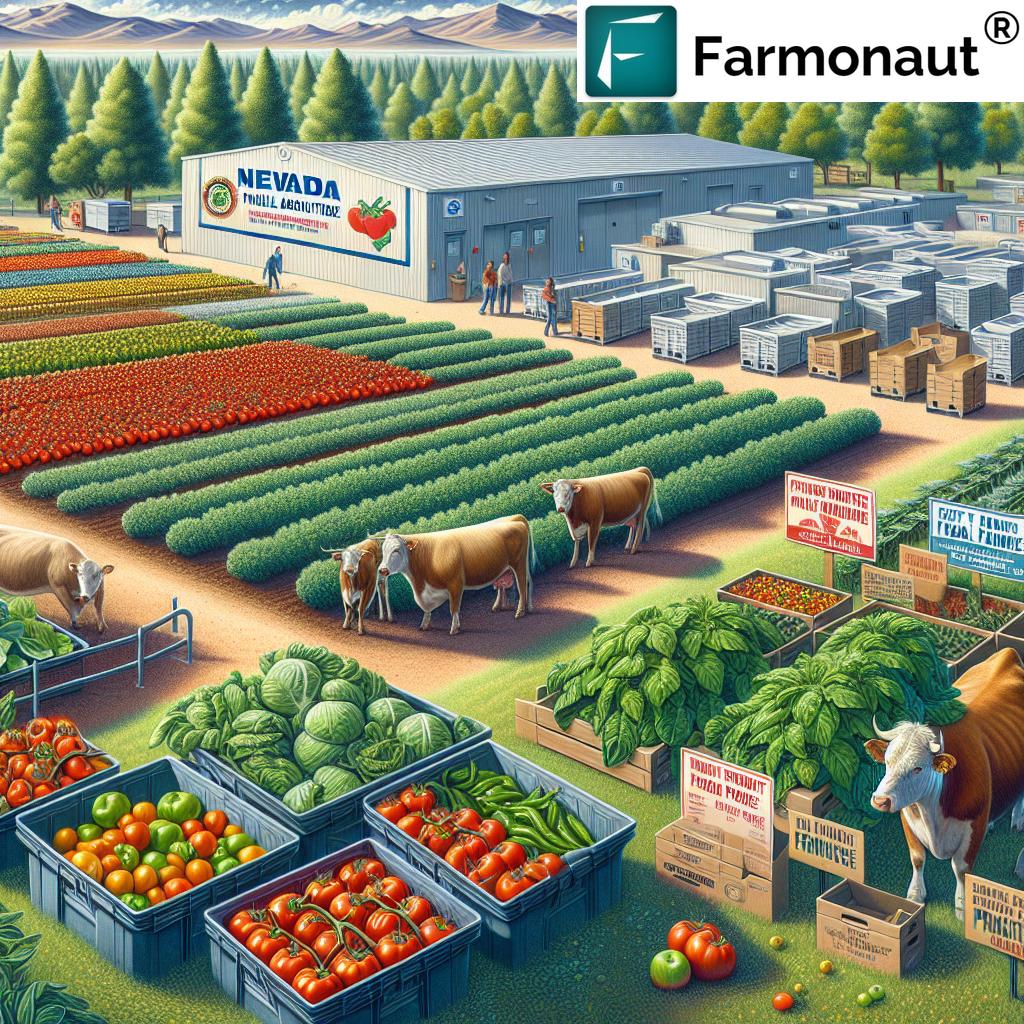Nevada Food Bank Deliveries USDA Cuts: Local Impacts – Building Community Resilience in Agriculture & Food Security (2025)
Table of Contents
- Introduction: The Foundation of Nevada’s Local Food Resilience
- Trivia: The Stark Reality of Food Assistance Cuts
- Nevada’s Agricultural Landscape: Diversity, Sustainability, and Community Value
- The Home Feeds Nevada Program: Fortifying Local Food Bank Programs
- USDA Funding Cuts 2025: Threats to Nevada Local Agriculture and Food Security
- Comparative Impact Table: Nevada Counties Before & After USDA Cuts
- Local Implications: Food Bank Shortfalls and Support for Local Farmers
- State Agricultural Initiatives: Nevada’s Response and Legislative Support
- Toward Sustainable Farming Practices Nevada: Technology’s Role
- How Farmonaut Empowers Nevada’s Agricultural Resilience
- Trivia: Nevada’s Reliance on Local Agriculture for Food Security
- Building Resilient Local Food Systems for Nevada’s Future
- Frequently Asked Questions
Introduction: The Foundation of Nevada’s Local Food Resilience
Nevada Food Bank Deliveries USDA Cuts threaten to reshape the foundation of food security in our state. Within Nevada’s distinctive agricultural landscape, our communities have long relied on innovative local agriculture initiatives and the resilience of Nevada’s farmers, ranchers, and food bank programs. But the 2025 USDA funding cuts to vital programs challenge our ability to maintain local food systems resilience and deliver fresh foods to all Nevadans.
In this in-depth blog, we explore the local impacts of recent federal policy changes — particularly how the cancellation of the Local Food for Schools (LFS) and Local Food Purchase Assistance (LFPA) programs has affected everything from food banks in northern and southern Nevada to small-scale agricultural producers and families facing food insecurity. We’ll also highlight proactive state responses, sustainable practices, the power of new technology like Farmonaut, and how we can mobilize for a more sustainable, resilient future.
“Nevada food banks face a 30% reduction in USDA deliveries, impacting thousands of families’ access to fresh, local produce.”
Nevada’s Agricultural Landscape: Diversity, Sustainability, and Community Value
The story of Nevada local agriculture is one of resilience and innovation. Our agricultural sector encompasses a range of products — from cattle and dairy to vegetables like tomatoes, and even specialty crops like coffee. Despite Nevada’s predominantly arid terrain, our farmers and ranchers have developed adaptive, sustainable farming practices to contribute a diverse, nutritious range of foods to local communities.
- Resilience: Nevada’s climate challenges require adaptive farming and resourceful water management.
- Diversity of Products: Cattle, dairy, tomatoes, leafy greens, eggs, and specialty products such as coffee beans.
- Community Impact: Local farms and food systems create jobs, support rural economies, and provide fresh, locally sourced produce to Nevada communities.
- Innovation: Adoption of technology and sustainable agriculture methods to optimize yields and preserve resources.
Yet, food security in Nevada remains volatile. Access to consistent, nutritious, and affordable food is sometimes threatened by external economic shocks, especially among our most vulnerable. Thus, local agricultural programs and targeted funding are essential to link Nevada’s farms and ranches directly to community food assistance efforts.
The Home Feeds Nevada Program: Fortifying Local Food Bank Programs
One of the most impactful state agricultural initiatives in recent years, the Home Feeds Nevada program epitomized local food systems resilience. Founded in 2022 and initially funded by the American Rescue Plan Act, Home Feeds Nevada provided the means for food banks (like Three Square and the Food Bank of Northern Nevada) to directly purchase locally grown, produced, and processed foods — supporting Nevada’s farmers and ranchers alongside families facing food insecurity.
- How it Worked: Nevada food banks used program funds to purchase fresh, nutritious foods (dairy, protein, fruits, and vegetables) from in-state farms and ranches.
- Stabilizing Local Markets: Gave small and midsize producers a consistent, reliable market for their output, decreasing the volatility traditional agriculture often faces.
- Community Nutrition: Provided locally sourced produce to food-insecure Nevadans, improving nutrition and reducing carbon footprint.
By intertwining economic viability for local farms and access to fresh foods for communities, the program advanced food security in Nevada and broader sustainability objectives.
USDA Funding Cuts 2025: Threats to Nevada Local Agriculture and Food Security
In March 2025, the landscape shifted dramatically. The USDA announced the termination of two critical programs: the Local Food for Schools Cooperative Agreement Program (LFS) and the Local Food Purchase Assistance Cooperative Agreement Program (LFPA). Before these funding cuts, Nevada’s LFS and LFPA allocations combined topped $8 million annually — funds that flowed to schools, food banks, farmers, ranchers, and ultimately the entire community.
- LFS & LFPA Purpose: These federally funded initiatives empowered the purchase of locally grown foods for schools and food pantries, creating a powerful link in the food system.
- 2025 Cuts: Both programs abruptly ended, nullifying $4.1 million destined for LFS and $3.9 million for LFPA in the 2025 fiscal year, directly impacting Nevada’s food assistance capacity (source).
- Immediate Fallout: Canceled contracts for hundreds of thousands of pounds of local produce, dairy, and proteins — and lost revenue for small and medium-sized local producers.
- Schools/Community Impact: Schools lost a vital supply of fresh, nutritious foods for programs serving low-income children and families.
Consequently, the interlinked systems supporting Nevada’s food security, farmer income, and sustainable local supply chains all suffered — exposing the fragility created by federal-dependency.
Comparative Impact Analysis: Food Availability Before & After USDA Funding Cuts
To visualize the impact, let’s examine estimated figures for local food banks in several Nevada counties. These estimates reflect the drastic changes in fresh produce distribution and household service capacity following the loss of USDA LFS and LFPA support in 2025:
| Local Area/County | Estimated Households Served (Pre-Cuts) | Estimated Households Served (Post-Cuts) | Estimated Fresh Produce Distributed (Tons, Pre-Cuts) | Estimated Fresh Produce Distributed (Tons, Post-Cuts) | Key Local Challenges (Brief Description) |
|---|---|---|---|---|---|
| Clark County (Southern Nevada) | 72,000 | 54,000 | 3,500 | 2,100 | Surging demand, reduced availability of fresh foods, longer wait times for assistance. |
| Washoe County (Northern Nevada) | 40,000 | 28,500 | 1,750 | 950 | Loss of contracts for Northern Nevada producers; limited protein and dairy offerings in local pantries. |
| Lyon County | 10,000 | 6,500 | 610 | 305 | Noticeable drop in tomato, dairy, and eggs for low-income families. |
| Elko County | 6,500 | 4,200 | 320 | 140 | Rural food pantries struggle to acquire locally grown produce and protein foods; increased transport costs. |
| White Pine County | 4,100 | 2,750 | 130 | 58 | Acute shortage of fresh foods, delayed food bank deliveries, rising demand amid stagnant resources. |
This table underscores a statewide trend: after funding cuts, tens of thousands fewer Nevada families receive locally produced food, while local agriculture markets become less stable and less diverse.
Food Bank Shortfalls and Support for Local Farmers: The Ripple Effects of Funding Cuts
The direct consequences of Nevada’s USDA agricultural funding cuts are felt by every link in the local food system:
Local Food Bank and Food Security Impacts
- Reduced Deliveries: The Food Bank of Northern Nevada (serving 160,000 people monthly) canceled 350,000 pounds of deliveries between April–August 2025 (Source).
- Nutrition Gaps: Fewer fresh, locally sourced foods for children, seniors, and families; increased risk of reliance on shelf-stable and lower-nutrition items.
- Insecurity Climb: Spikes in food insecurity rates as federal assistance declines, with many food banks closing enrollment or rationing services.
Impact on Nevada Producers and Local Farmers
- Lost Markets: Small farms and ranches no longer have guaranteed buyers for dairy, protein, and fresh produce; significant income instability.
- Reduced Agricultural Activity: Farms scale back production (especially perishable goods) due to uncertain demand, threatening agricultural diversity.
- Long-Term Sustainability Threatened: Local food systems lose momentum in the shift to sustainable, scalable, environmentally-friendly supply chains.
The net result: diminished food security in Nevada and increased economic pressure on the state’s agricultural foundation.
State Agricultural Initiatives: Nevada’s Legislative Support for Local Food Systems Resilience
In the face of federal withdrawal, Nevada’s policymakers have acted swiftly to buffer the effects of agricultural funding cuts. Recognizing the essential role of the Home Feeds Nevada program and the broader local food ecosystem, the state introduced several responsive measures:
- Senate Bill 233 (SB233): Spearheaded by Senator Fabian Doñate, this bill allocates $800,000 over the next two years to sustain the Home Feeds Nevada program, directly supporting local food bank initiatives and purchase agreements for locally grown foods. (Source)
- Emphasis on Locally Sourced Produce: Enhanced focus on contracting with local producers and processors, keeping dollars circulating within the state economy.
- Cross-Sector Collaboration: While federal support wanes, state legislators explore partnerships with private sector, philanthropy, and local food advocates to strengthen Nevada’s food supply chain.
- Community Engagement: Public-awareness campaigns and stakeholder engagement to promote the value of supporting local food systems — amplifying the call for resilience and sustainability.
These policy actions signal Nevada’s commitment to overcoming short-term setbacks and establishing a durable, scalable local food infrastructure, with the Home Feeds Nevada program as a backbone for state agricultural initiatives going forward.
Enhance your state’s sustainable farming practices with Farmonaut’s carbon footprint tracking tools — monitor your farm’s environmental impact in real time, take steps to reduce emissions, and align operations with sustainability goals across Nevada and beyond.
Toward Sustainable Farming Practices in Nevada: The Critical Role of Technology
If there is a lesson in these challenging times for Nevada agriculture, it is this: a resilient, sustainable system depends on the integration of advanced technology, sound policy, and strong local-community networks. Innovations in precision agriculture and digital farm management can help Nevada farmers weather the loss of federal support and build a foundation for sustainable practices.
- Data-Driven Resource Management: Efficient allocation of water, fertilizer, and energy preserves resources and improves crop yields.
- Traceability: Verifiable, transparent food supply chains reinforce consumer trust and create possibilities for premium market positioning.
- Environmental Monitoring: Tracking environmental metrics — like emissions and soil health — accelerates the shift towards carbon-neutral, eco-friendly farming.
Embracing these tools is critical not just for resilience against future funding cuts, but also for growing the value of Nevada’s agricultural diversity and fulfilling our commitment to food security in Nevada.
Read more about blockchain-based traceability for Nevada agriculture. Trace the path of every product from farm to table, support transparency, and satisfy modern consumer demands.
How Farmonaut Empowers Nevada’s Agricultural Resilience and Local Food Systems
Farmonaut stands at the forefront of empowering sustainable farming practices in Nevada and fortifying local food systems, especially as funding challenges threaten traditional support. Our suite of technologies — accessible via Android, iOS, browser, or API — democratizes precision agriculture for producers of all sizes, reducing costs, increasing productivity, and advancing environmental goals across Nevada’s agricultural landscape.
What Farmonaut Delivers to Nevada Farmers and Food Systems:
- Satellite-Based Crop Health Monitoring: Real-time, field-level data on crop growth and health using multispectral imagery — guiding actionable decisions on irrigation, fertilization, and pest control for Nevada’s diverse produce.
- AI-Driven Advisory: Jeevn AI delivers expert, personalized recommendations, weather forecasts, and management advice via mobile, making expertise accessible for every rancher and farmer in Nevada.
- Blockchain-Based Traceability: Secure transparency at every link of the local food supply chain; essential for food banks, retailers, and consumers prioritizing locally sourced, sustainable foods.
- Fleet and Resource Management: Advanced fleet tracking reduces operational costs for producers distributing dairy, protein, and produce both regionally and locally.
- Carbon Footprint Tracking: Nevada’s producers and agribusinesses can monitor and reduce emissions — unlocking access to ‘green’ supply chains and future regulatory compliance.
- Integrated API Solutions: Developers, agencies, and agricultural businesses throughout Nevada can seamlessly integrate Farmonaut satellite and weather data for advanced analytics, insurance verification, and beyond.
Our value proposition is simple: Make sustainability scalable, empower every farmer with affordable, actionable data, and provide the backbone for Nevada’s next era of food system resilience.
For custom solutions, access Farmonaut’s API Developer Documentation and create new agri-applications for your Nevada community or business.
Explore Farmonaut’s crop loan and insurance verification services to help Nevada farmers secure financing with confidence — reducing risk for both producers and financial institutions.
Try Farmonaut – Affordable Subscriptions for Nevada Farmers
“Over 50% of Nevada’s food-insecure households rely on local agriculture, now threatened by recent federal funding cuts.”
Building Resilient Local Food Systems in Nevada’s Future
The crisis catalyzed by the Nevada Food Bank Deliveries USDA Cuts is both a challenge and an opportunity. As our experience over the past years demonstrates, food security for all Nevadans will increasingly depend on our own local food system resilience, the vitality of our farmers and ranchers, and our collective commitment to sustainability.
Key Strategies for Nevada Communities:
- State Investment: Prioritize and expand funding for Home Feeds Nevada and other state agricultural initiatives to restore key purchasing power for local food banks.
- Technology Adoption: Encourage producers and agribusinesses to implement advanced farm management, crop health monitoring, and transparent supply chain solutions such as Farmonaut.
- Community Partnerships: Form alliances between local governments, nonprofits, and businesses to advocate for food sovereignty and reduce dependency on volatile federal assistance.
- Public Awareness: Educate citizens about the benefits of locally sourced produce and empower them to support Nevada-grown foods in their purchasing choices.
- Sustainability as Core Value: Center all future food banking and agricultural development on sustainable principles — closing resource loops, reducing waste, and prioritizing climate-friendly practices.
By focusing on these goals, Nevada is poised to become a national model for how states can safeguard food security, fortify local food systems resilience, and achieve enduring agricultural sustainability, even amid unpredictable federal funding.
Frequently Asked Questions (FAQ)
What are the Local Food for Schools (LFS) and Local Food Purchase Assistance (LFPA) programs?
LFS and LFPA are USDA-funded cooperative initiatives that allowed Nevada schools and food banks to buy locally grown foods directly from Nevada farmers and ranchers. The 2025 cancellation of these programs created a major funding gap for food security and agricultural resilience.
How do USDA funding cuts impact food security in Nevada?
USDA cuts have resulted in reduced food bank deliveries, fewer households receiving fresh produce, and significant lost revenue for Nevada’s local agricultural producers.
What is the Home Feeds Nevada program?
A state-funded initiative supporting food banks’ direct purchase of locally sourced produce and agricultural products, benefiting both families struggling with food insecurity and local farms/ranches.
How is Farmonaut relevant to Nevada’s agricultural and food security challenges?
Farmonaut delivers affordable, scalable technology solutions (such as satellite crop monitoring, fleet management, and supply-chain traceability) that empower Nevada farmers/ranchers to increase productivity, improve sustainability, and secure resilience against future funding interruptions.
How can local citizens support food security and sustainability in Nevada?
By advocating for state investment in local agriculture, supporting food banks, choosing locally grown foods, and fostering sustainability-focused policies and purchasing habits.
Conclusion: Nevada’s Path Forward in Agricultural Sustainability
The ripple effect of Nevada Food Bank Deliveries USDA Cuts reaches every corner of our state — from the shelves of food banks in Reno and Las Vegas to the fields and pastures of our northern and southern agricultural producers. Yet, as this guide shows, collective action, proactive policies, adoption of innovative agri-solutions like Farmonaut, and community-level investment in sustainability can turn adversity into an opportunity for long-term food security in Nevada. It is only through these combined efforts that we ensure Nevada’s farms, food banks, and communities remain resilient for generations to come.















